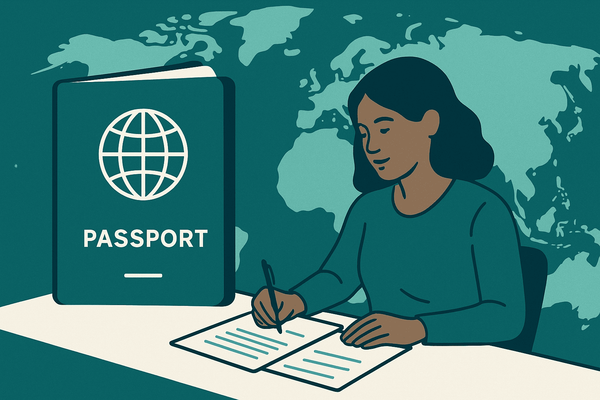Immigration statistics and trends

Immigration statistics tell us how many people move to different countries and why. Governments and organizations use this data to make informed decisions about policies, economies, and social programs.
Why do these numbers matter?
- Track global trends – More people than ever are migrating for work, education, or safety.
- Help governments plan – Countries use data to manage job markets, housing, and social services.
- Impact the economy – Immigration affects wages, job availability, and economic growth.
- Shape policies – Laws and visa programs are adjusted based on migration trends.
- Dispel myths – Data helps counter misinformation about immigration.
Global immigration trends
Total number of international migrants worldwide
As of 2024, there are approximately 304 million international migrants worldwide, representing about 3.7% of the global population. Historical data shows that this number has nearly doubled since 1990, when migrants made up only 2.9% of the world’s population.
For context, if all migrants formed a single nation, it would be the fourth largest country in the world.
Regions with the highest immigration rates
Migration is not evenly distributed worldwide. Over half of all international migrants live in just two regions: Europe and North America.
Here’s how migration numbers break down:
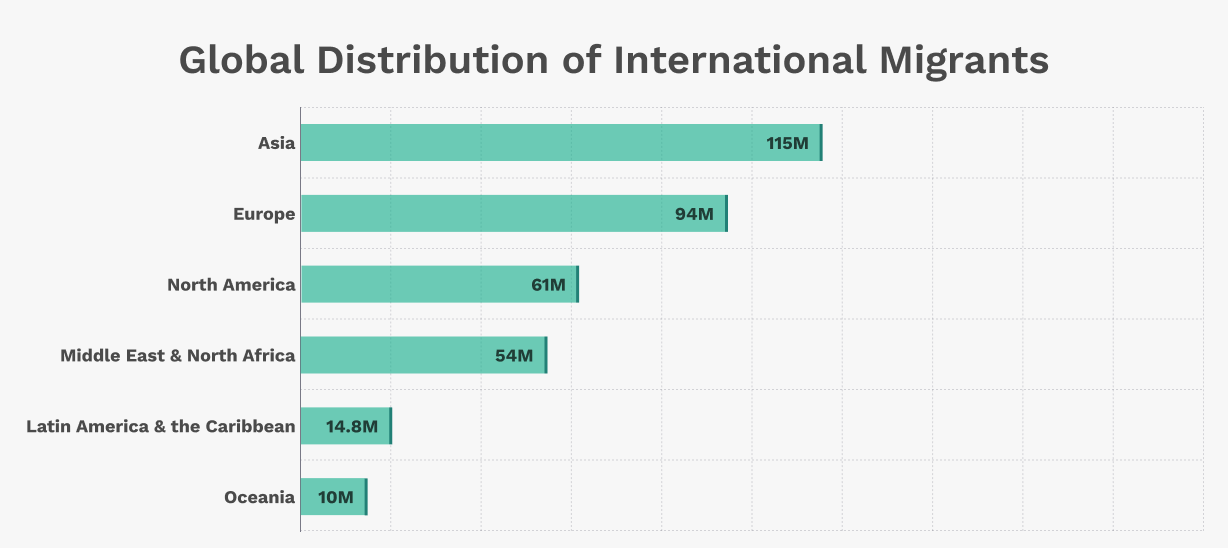
- Europe: 94 million
- Asia: 115 million
- North America: 61 million
- Middle East & North Africa: 54 million
- Latin America & the Caribbean: 14.8 million
- Oceania: ~10 million
Some nations stand out with particularly high immigration rates. The United Arab Emirates and Qatar have immigrant populations making up 88% and 77% of their total residents, respectively, due to labor migration.
Changes over the past decade
Global immigration patterns have shifted significantly in the last ten years. Key trends include:
- A rapid rise in migration: The world added 60 million more migrants between 2010 and 2020, outpacing general population growth.
- Increased refugee and asylum seeker migration: Conflicts in Syria, Afghanistan, Venezuela, and Ukraine led to record-high numbers of refugees and asylum seekers. By 2020, refugees made up 13 million of the global migrant increase.
- Changes in destination regions: Europe saw a sharp increase in immigrants due to humanitarian crises, while migration growth in North America slowed compared to previous decades.
- COVID-19 disruption: The pandemic briefly halted migration flows in 2020, but numbers quickly rebounded in 2021 and 2022, reaching record levels in many countries.
Future projections
Looking ahead, experts predict continued growth in migration due to economic, demographic, and environmental factors:
- Aging populations in developed countries: Europe, North America, and East Asia will increasingly rely on migrants to fill labor shortages.
- Economic disparities: Wage gaps between regions will continue to drive migration, particularly from South Asia and Africa to wealthier economies.
- Climate migration: Rising sea levels, droughts, and natural disasters are expected to displace millions, leading to increased migration in the coming decades.
By 2050, the global migrant population could surpass 400 million, making migration a defining feature of the 21st century. Countries must adapt policies to balance economic needs, integration, and humanitarian considerations.
Immigration by region
North America (U.S., Canada, Mexico)
North America is home to over 61 million immigrants, with the U.S. leading globally with 47.8 million foreign-born residents, making up 14.3% of its population.
Canada follows with 8.36 million immigrants (23% of its population), while Mexico hosts around 1.21 million foreign-born people, primarily from the U.S. and Guatemala.
Largest immigrant groups:
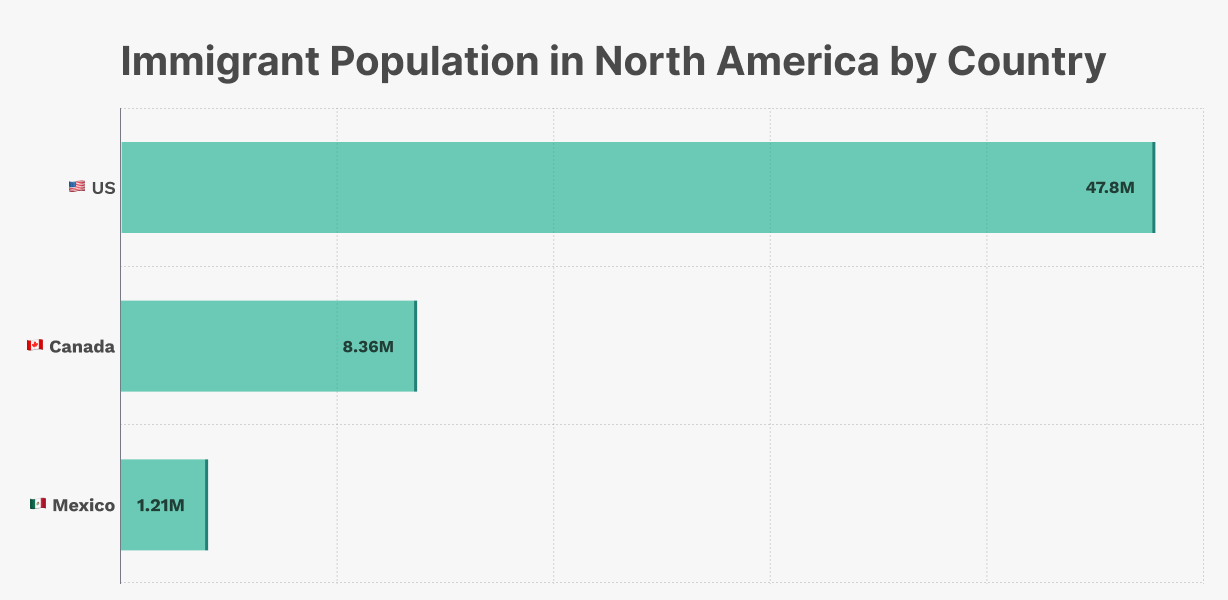
- U.S.: The largest groups come from Mexico (10.6 million), India, China, the Philippines, and El Salvador.
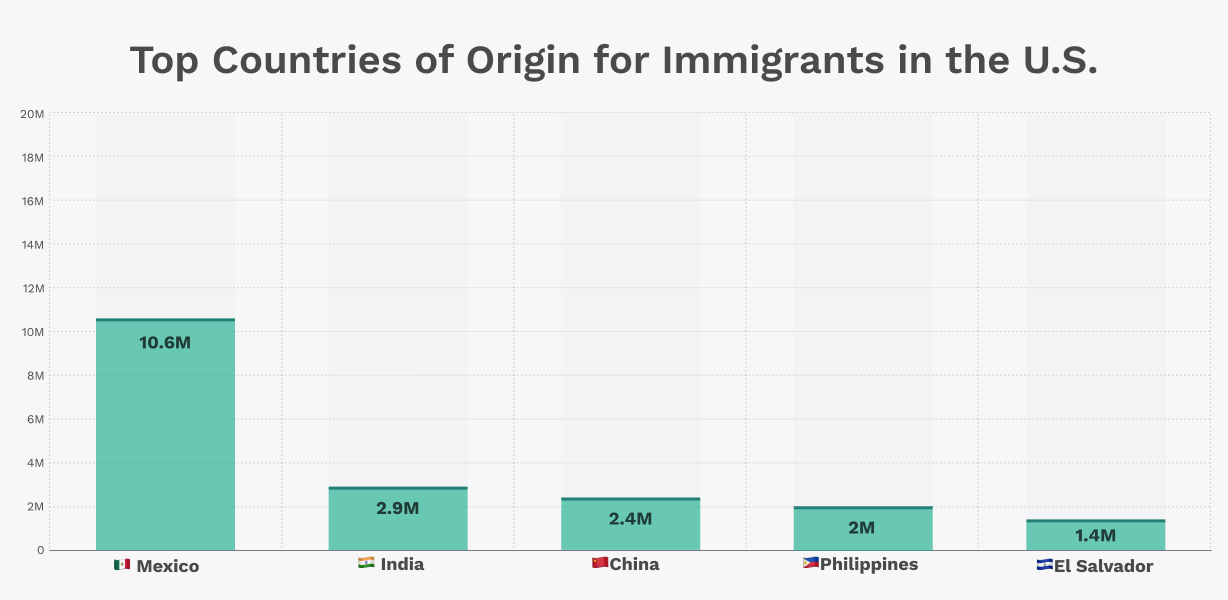
- Canada: Primarily from India (10.7% of all immigrants), the Philippines, and China.
- Mexico: Mainly from the U.S. and Central America.
Economic impact
Immigrants significantly contribute to North America's economy:
- In the U.S., immigrants generated about $1.6 trillion in economic output in 2022 and paid $579 billion in taxes.
- Immigrants make up 17% of the U.S. labor force, particularly in STEM, healthcare, and agriculture.
- In Canada, 32% of all business owners are immigrants, and new arrivals are responsible for 75% of labor force growth.
- Mexico receives $58.5 billion annually in remittances, primarily from the U.S.
Recent migration trends
- The U.S. saw an increase of 1.6 million immigrants from 2022 to 2023, the largest in decades.
- Canada welcomed 431,645 new permanent residents in 2022, aiming for 500,000 annually by 2025.
- Mexico received 118,800 asylum applications in 2022, making it the 4th-largest asylum recipient worldwide. This highlights the significant role of asylum seekers in recent migration trends in North America.
Europe
Europe hosts about 87 million immigrants, the highest among all regions.
EU migration policies and statistics
- The New Pact on Migration and Asylum (2024) introduces common EU asylum rules and responsibility-sharing among member states.
- The Schengen Area allows free movement within 27 countries.
- The EU received 1 million asylum applications in 2023, mainly from Syria, Afghanistan, and Venezuela.
Refugee and asylum applications
- Germany, France, and Spain receive the most asylum claims.
- The Ukraine conflict has led to over 5 million refugees relocating across Europe.
- Turkey hosts 3.6 million Syrian refugees, the largest number worldwide.
Asia-Pacific
Asia is a major hub for labor migration and expatriate communities.
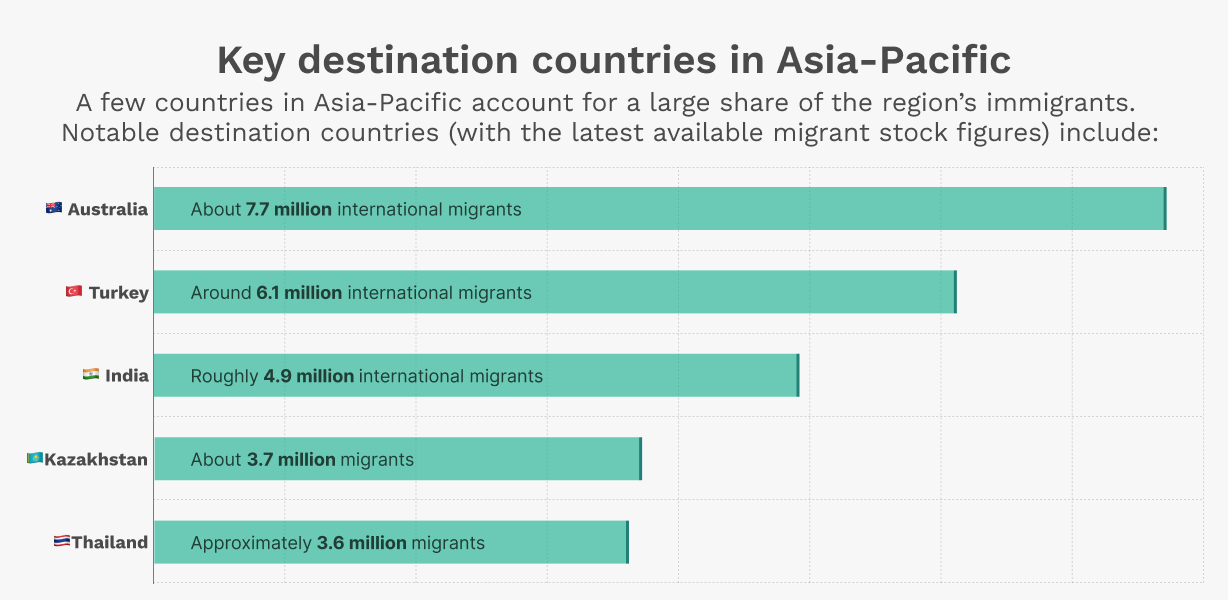
Major migration flows
- Gulf states host 8.5 million Indian workers, with millions also from Pakistan, Bangladesh, and the Philippines.
- Southeast Asia has strong intra-regional migration, with Myanmar and Cambodia sending workers to Thailand and Malaysia.
- Australia and New Zealand attract skilled migrants through structured immigration programs, allowing them to become lawful permanent residents.
Key destination countries in Asia-Pacific:
A few countries in Asia-Pacific account for a large share of the region’s immigrants. Notable destination countries (with the latest available migrant stock figures) include:
- Australia – about 7.7 million international migrants (foreign-born residents) .
- Turkey – around 6.1 million international migrants . (Turkey straddles Europe and Asia; UN data often counts it in Asia for migration.)
- India – roughly 4.9 million international migrants (many from neighboring South Asian countries).
- Kazakhstan – about 3.7 million migrants (largely from other former Soviet states) .
- Thailand – approximately 3.6 million migrants (mainly from within Southeast Asia) .
Policy changes
- Japan aims to admit 345,000 foreign workers over five years.
- South Korea expanded its employment permit system for migrant workers.
- ASEAN agreements facilitate skilled worker mobility among member states.
Latin America
Migration in Latin America is driven by economic instability, violence, and political crises.
Key destination countries in Latin America:
A handful of Latin American countries host the majority of the region’s immigrants. The largest destination countries (with estimated migrant stocks as of ~2020) are:
- Argentina – about 2.3 million international migrants (historically from Europe and neighboring countries).
- Colombia – roughly 1.9 million migrants (many are recent arrivals from Venezuela).
- Chile – around 1.6 million migrants (a rapidly growing foreign-born population, including Venezuelans and Haitians).
- Venezuela – approximately 1.3 million migrants (including Colombians and others who arrived before Venezuela’s own crisis).
- Peru – about 1.2 million international migrants (boosted by inflows from Venezuela in the last decade).
Migration within the region and to the U.S.
- 7.7 million Venezuelans have left their country, with 6.5 million resettling in Latin America.
- Colombia hosts 2.9 million Venezuelans, followed by Peru (1.5 million) and Ecuador, Chile, and Brazil.
- Central American migration to the U.S. remains high due to poverty and violence, with a significant number of unauthorized immigrants making the journey.
Political and economic drivers
- Remittances are crucial: Latin American migrants sent over $142 billion home in 2022.
- Crime, economic instability, and political repression in Venezuela, Haiti, and Nicaragua continue to drive emigration.
Africa
Africa experiences high levels of internal migration and significant emigration to Europe and the Middle East.
Internal migration vs. international migration
- 80% of African migrants stay within Africa, often moving for jobs or safety.
- South Africa and Côte d’Ivoire are major intra-regional destinations.
- 20% of African migrants go abroad, mainly to Europe and the Gulf.
Brain drain and remittance impact
- 70,000 skilled professionals leave Africa annually, causing labor shortages.
- Remittances to Africa totaled $100 billion in 2022, with Nigeria receiving the most ($20 billion).
- Some nations (e.g., Nigeria, Kenya) are experiencing a brain gain with skilled migrants returning.
Middle East
The Middle East is defined by labor migration and refugee displacement.
Labor migration to gulf countries
- The GCC countries (Saudi Arabia, UAE, Qatar, etc.) rely heavily on foreign labor, with 30 million foreign workers.
- In the UAE, 88% of the population is foreign-born, while Qatar has 77-85% immigrants.
- Migrants, mainly from South Asia, work in construction, domestic services, and oil industries.
Refugee movements due to conflicts
- The Syrian civil war displaced 6.5 million refugees and asylum seekers, with Turkey (3.6 million) hosting the most.
- Lebanon has 820,000 Syrian refugees, making up 10% of its population.
- Yemen’s war has left 4.5 million internally displaced persons, while Palestinian refugees remain stateless in multiple countries.
Migration patterns continue to shape global economies and demographics. The next chapter will explore key drivers behind migration and what compels people to leave their home countries.
Key drivers of migration
Migration is influenced by a variety of factors, ranging from economic opportunities to political instability. Understanding these drivers helps explain why people leave their home countries and where they choose to go.
Economic factors
Job opportunities and wages
- Large wage gaps drive migration. Workers in high-income countries earn significantly more than in developing nations.
- Migrants make up 169 million international workers, nearly 5% of the global workforce. The legal status of migrants significantly affects their job opportunities and wages, with authorized migrants often having access to better-paying jobs compared to unauthorized migrants.
- The U.S., Canada, and Australia attract the highest numbers of skilled migrants, while Gulf countries employ millions of low-wage workers in construction and domestic work.
Remittances
- Migrants sent $626 billion to low and middle-income countries in 2022.
- India received over $100 billion, followed by Mexico (~$60B), China (~$51B), the Philippines (~$38B), and Egypt (~$32B).
- Some economies heavily depend on remittances, with Nepal and Haiti relying on them for over 20% of GDP.
Political and social factors
War, conflict, and persecution
- At the end of 2022, there were 108.4 million forcibly displaced people, including 29.4 million refugees.
- 52% of all refugees came from Syria, Ukraine, and Afghanistan.
- Turkey hosts 3.6 million refugees, the most globally, followed by Iran (3.4M), Colombia (2.5M), Germany (2.1M), and Pakistan (1.5M).
- 71% of refugees are in countries neighboring their home nations.
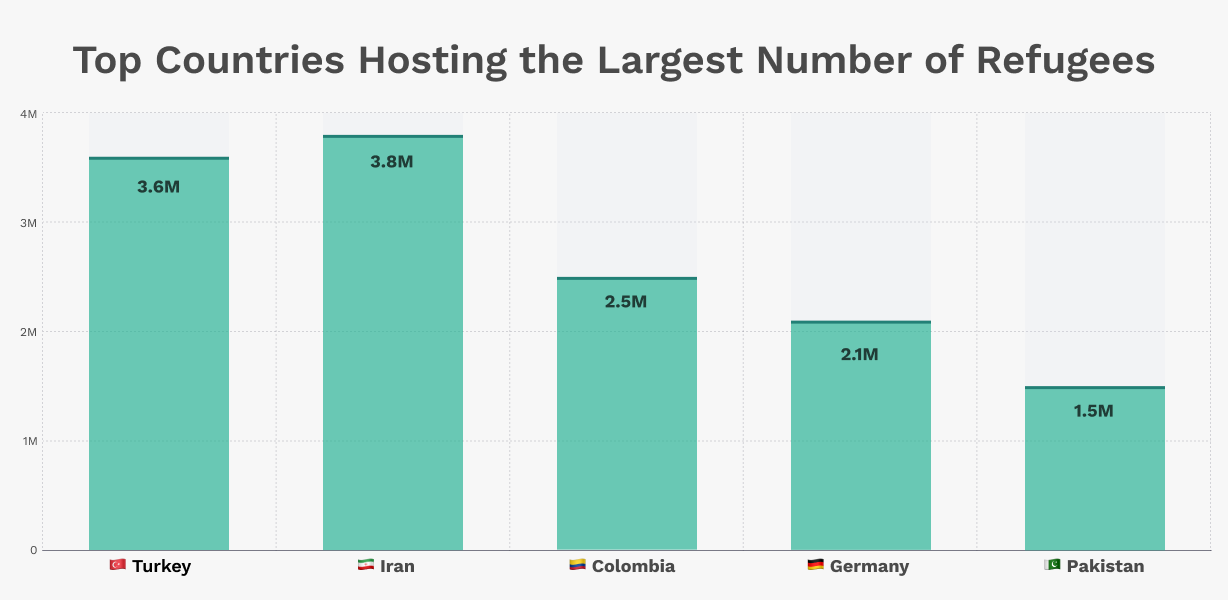
Government policies and corruption
- Authoritarian rule and economic mismanagement force emigration.
- Hong Kong’s 2020 national security law led to increased migration to the UK, Canada, and Australia.
- Venezuela's crisis has displaced millions across Latin America.
Climate change and environmental factors
Climate-induced displacement
- 32.6 million people were displaced by climate disasters in 2022, a 40% increase from 2021.
- 98% of disaster-induced displacements were caused by floods, storms, and droughts.
- Pakistan’s 2022 floods displaced 8.2 million people, accounting for one-quarter of global disaster displacements that year.
- By 2050, climate change could force 216 million people to migrate, with South Asia and Africa being the most vulnerable regions.
Natural disasters
- Severe drought in the Horn of Africa displaced 2.1 million people, including 1.1 million within Somalia.
- Rising sea levels force thousands of Bangladeshis inland each year.
- Countries with frequent storms, like the Philippines and Indonesia, see regular displacement due to typhoons and monsoons.
Education and professional opportunities
Student migration
- The number of students studying abroad has tripled from 2 million in 2000 to 6 million in 2019.
- The U.S., UK, Australia, Canada, and New Zealand attract 50% of all international students.
- The U.S. hosts ~1.1 million international students, UK (~600K), Australia (~400K), France, and Germany.
Skilled migration and brain drain
- Over two-thirds of highly educated migrants settle in the U.S., UK, Canada, and Australia.
- The OECD reported 27.3 million tertiary-educated immigrants, a 70% increase from 2000.
- High-income nations actively attract professionals in tech, medicine, and engineering.
- Many developing nations experience brain drain, with some losing over 20% of their skilled workforce to migration.
Migration is complex, driven by economic, political, and environmental factors. The next chapter will explore the impact of immigration on host countries, including economic contributions, cultural integration, and policy challenges.
Impact of immigration on host countries
Immigration profoundly affects host countries, influencing their economies, labor markets, social dynamics, and policies. While immigrants contribute significantly to economic growth, they also present challenges related to integration, housing, and public services.
Economic contributions
Labor force and job creation
- 15% of all workers in OECD countries were foreign-born in 2022, helping to fill labor shortages in healthcare, construction, and agriculture industries.
- Immigrants account for 80% of Europe’s population growth from 2000 to 2018, sustaining labor markets amid aging native-born populations.
- In countries like Germany and the UK, immigrants fill more than 30% of healthcare jobs, providing essential services in aging societies.
- Without migration, many advanced economies would experience slower GDP growth and declining workforce participation rates.
GDP and tax contributions
- In OECD countries, immigrants’ net fiscal impact is typically between -1% and +1% of GDP, showing they generally contribute as much as they receive in public services.
- In the U.S., immigrant-founded companies generate billions in revenue and employ millions of workers, contributing heavily to economic expansion.
- Migrants sent $831 billion in remittances globally in 2022, surpassing foreign direct investment flows to many low and middle-income countries and providing crucial financial support to families and economies.
- In Canada, immigrants contribute nearly 50% of total labor force growth, ensuring long-term economic sustainability.
Entrepreneurship and innovation
- 17% of entrepreneurs in OECD countries were immigrants in 2022, up from 11% in 2006.
- Immigrant-founded businesses created nearly 4 million jobs between 2011 and 2021, fueling local economies and innovation hubs.
- 44.8% of Fortune 500 companies in 2023 were founded by immigrants or their children, demonstrating their role in shaping leading global industries.
- Over half of billion-dollar startup companies in the U.S. were founded by immigrants, particularly in technology and biomedical fields.
- In the UK, immigrants are twice as likely to start a business as native-born citizens, contributing to diverse economic opportunities.
Demographic effects
Population growth and aging societies
- High-income countries gained 80.5 million people via immigration between 2000 and 2020, offsetting declining birth rates.
- By 2054, migration will be the primary source of population growth in 52 countries, including major economies like the U.S., Germany, and Japan.
- Immigration accounted for 80% of Europe’s population growth in recent decades, compensating for shrinking native-born populations.
- The UN predicts immigration will mitigate population decline in 50 countries, preventing economic contraction due to an aging workforce.
- In Japan, where 30% of the population is over 65, immigration is seen as an essential tool to sustain economic output and workforce stability.
Housing and infrastructure challenges
Housing demand
- A 1% increase in immigration to a city raises average rents by ~0.5% and housing prices by ~1%, highlighting the strain on urban housing markets.
- London, New York, and Toronto face housing affordability issues, partly due to high demand from immigrants seeking jobs in major metropolitan areas.
- In response, governments have introduced affordable housing initiatives to ensure sustainable urban development while accommodating immigrant populations.
- Germany has invested over €5 billion in housing expansion programs to keep up with migration-driven demand.
Public services
- 24% of doctors and 16% of nurses in OECD countries are foreign-born, highlighting the importance of immigration in healthcare systems.
- Immigrants contribute to social security and tax revenues, supporting public services and pension programs that would otherwise face funding deficits.
- In Sweden and Canada, governments provide integration assistance, such as housing, language training, and job placement, to help immigrants contribute to society faster.
- Cities with large immigrant populations, such as Los Angeles and Paris, have expanded transportation and infrastructure projects to accommodate growing communities.
Integration policies
Employment and education outcomes
- Immigrants in OECD countries reached a record-high 72% employment rate in 2022-2023, showing strong labor market integration.
- Unemployment among foreign-born workers fell to historic lows (~7.3%) in 2023, indicating increased demand for migrant labor.
- Providing language courses increases employment probabilities for refugees in Europe, with direct effects on economic participation and financial independence.
- Studies show that immigrants who participate in structured language and civic programs see higher wages, greater civic engagement, and improved integration outcomes.
- In Australia, government-funded job placement programs for skilled immigrants have led to employment rates exceeding 85% within five years of arrival.
Citizenship and social integration
- Over 80% of eligible immigrants in Canada become citizens, leading to better long-term economic and social outcomes.
- Increased investment in immigrant youth education improves second-generation employment and integration rates, closing income gaps with native-born citizens.
- Germany’s citizenship reform in 2023 allowed dual citizenship for immigrants, increasing social participation and economic stability.
- In the U.S., naturalized immigrants earn on average 8-11% more than non-citizen immigrants, demonstrating the benefits of long-term integration.
While immigration presents challenges, host countries benefit significantly from the economic, social, and cultural contributions of migrants. Strategic policies that focus on integration, housing, and labor force participation ensure long-term benefits.
Future migration trends and policy evolution
As global economic, political, and environmental conditions change, migration trends will continue to evolve. Governments and international organizations are developing policies to address the challenges and opportunities associated with migration in the coming decades.
Projected migration trends
Economic-driven migration
- Projected Labor Shortages: By 2050, Europe (EU + UK) could face 43.7 million worker shortages without increased immigration.
- Workforce Growth from Immigration: In the U.S., all net workforce growth from 2015-2035 is expected to come from immigrants.
- High-Demand Sectors: 169 million international migrant workers globally fill labor shortages in healthcare, construction, and transport.
- Economic Contribution: Without immigration, aging populations would lead to workforce shrinkage. Migrants contribute significantly, with labor migration sustaining key industries worldwide.
Climate-induced displacement
- Climate Migrants by 2050: The World Bank estimates 216 million people may be displaced within their own countries due to climate change.
- Most Affected Regions: 86 million in Sub-Saharan Africa, 49 million in East Asia & Pacific, 40 million in South Asia, 19 million in North Africa could face climate-induced displacement.
- Governmental Responses: Countries such as Bangladesh and Pacific Island nations are creating relocation strategies for communities affected by sea-level rise and extreme weather.
- Adaptation vs. Migration: Investments in climate adaptation—such as sea walls and drought-resistant agriculture—are being prioritized to reduce forced migration.
Political instability and refugee movements
Record Refugee Numbers: As of 2024, there are 43.7 million refugees under UNHCR’s mandate, with total displacement reaching 122.6 million people globally.
Major conflict hotspots:
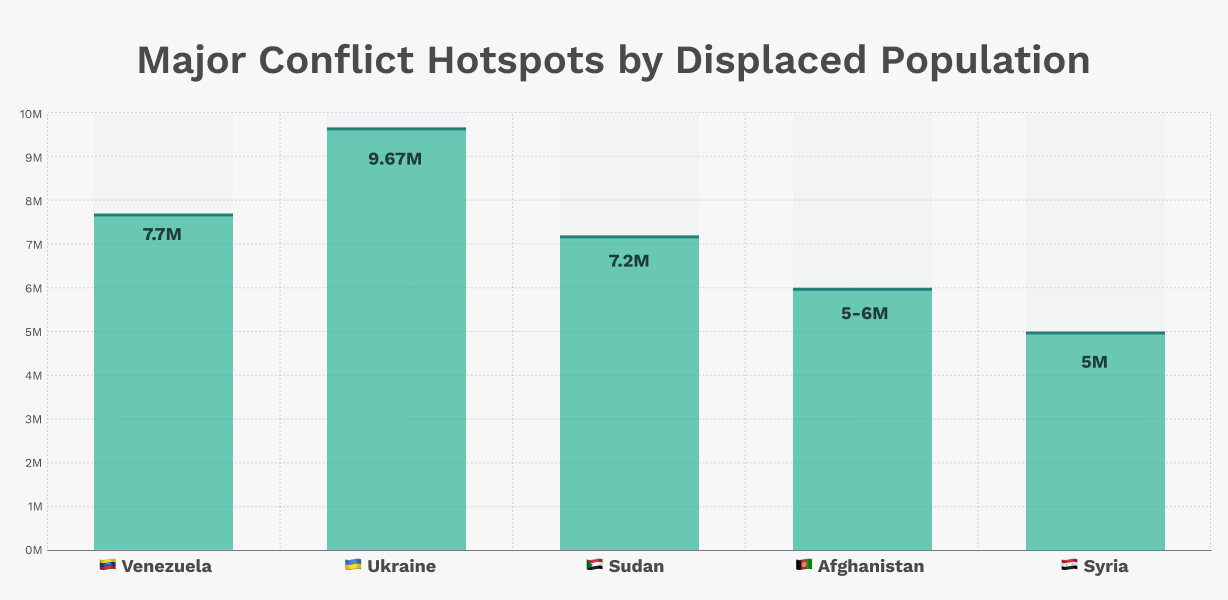
- Syria: 5 million refugees in neighboring countries.
- Ukraine: 6 million refugees in Europe, with an additional 5 million internally displaced.
- Afghanistan: 5.5–6 million Afghan refugees, primarily in Pakistan and Iran.
- Venezuela: 7.7 million Venezuelans have left since 2014, making this one of the world’s largest displacement crises.
- Sudan: Over 1 million refugees fled within months due to the 2023 conflict.
Future Projections: Displacement due to political instability and war could drive global refugee numbers past 150 million within the next decade.
Evolution of migration policies
Skilled migration programs
Expanding Talent Pipelines:
- Germany’s 2023 Immigration Reform: Introduces a points-based system for skilled workers.
- Canada’s Tech Talent Strategy: New work visas for highly skilled workers and tech professionals.
- EU Talent Partnerships: Facilitates legal migration from Africa and Asia.
Adjusting Targets:
- Canada initially set a 500,000 annual immigration target for 2025, but revised it to 395,000 in response to housing constraints.
- Countries like Australia and the UK are expanding pathways for skilled workers, prioritizing healthcare, STEM, and engineering sectors.
Border security and migration control
- U.S.-Mexico Border Measures: Over 2.76 million migrant encounters were recorded in 2022, leading to stricter asylum policies and expanded worker visa programs.
- EU Border Overhaul: The 2024 EU Pact on Migration and Asylum emphasizes faster border screening and tighter external border security.
- Externalization and Technology: Increasing use of AI-powered surveillance and biometric tracking to regulate migration flows.
Refugee and humanitarian policies
Temporary Protection for Crisis Zones:
- The EU’s Temporary Protection Directive provided 4.2 million Ukrainians with immediate residency and work rights.
- Latin American countries implemented humanitarian visas for Venezuelans fleeing economic collapse.
Resettlement and Legal Pathways:
- OECD countries granted protection to 676,000 refugees in 2023, the highest level since 2017.
- The Global Compact on Refugees (GCR) promotes equitable responsibility-sharing among host countries.
Integration and social inclusion
Labor Market & Language Integration:
- The employment rate for immigrants in OECD countries hit 72.3% in 2022, near parity with native-born workers.
- Language programs and credential recognition for foreign-trained professionals are being expanded to integrate migrants more efficiently.
Pathways to Citizenship:
- Germany’s 2024 law allows dual citizenship and reduces the residency requirement for naturalization to 5 years.
- Canada maintains one of the highest naturalization rates (80%+ among eligible immigrants).
Community Integration Initiatives:
- Cities are expanding mentoring programs and job training to improve long-term integration.
- EU and North American policies are shifting towards multicultural inclusion strategies.



